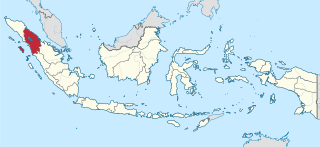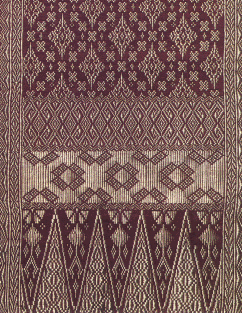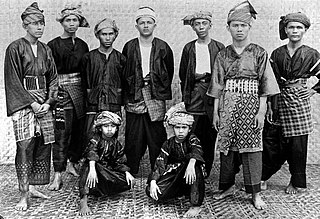
Minangkabau people, also known as Minang, are an Austronesian ethnic group native to the Minangkabau Highlands of West Sumatra, Indonesia. The Minangkabau's West Sumatran homelands was the seat of the Pagaruyung Kingdom, believed by early historians to have been the cradle of the Malay race, and the location of the Padri War.

Batik is an Indonesian technique of wax-resist dyeing applied to the whole cloth. This technique originated from the island of Java, Indonesia. Batik is made either by drawing dots and lines of the resist with a spouted tool called a canting, or by printing the resist with a copper stamp called a cap. The applied wax resists dyes and therefore allows the artisan to colour selectively by soaking the cloth in one colour, removing the wax with boiling water, and repeating if multiple colours are desired.

West Sumatra is a province of Indonesia. It is located on the west coast of the island of Sumatra and includes the Mentawai Islands off that coast. The province has an area of 42,012.89 km2, with a population of 5,534,472 at the 2020 census. The official estimate as at mid 2021 was 5,580,232. West Sumatra borders the Indian Ocean to the west, as well as the provinces of North Sumatra to the north, Riau to the northeast, Jambi to the southeast, and Bengkulu to the south. The province is subdivided into twelve regencies and seven cities. It has relatively more cities than other provinces outside of Java, although several of them are relatively low in population compared with cities elsewhere in Indonesia. Padang is the province's capital and largest city.

North Sumatra is a province of Indonesia located on the northern part of the island of Sumatra. Its capital and largest city is Medan. North Sumatra is Indonesia's fourth most populous province after West Java, East Java and Central Java, and also the most populous in the island of Sumatra. It covers an area of 72,981 km2. According to the 2020 census, the province's population in that year was 14,799,361. The mid-2021 official estimate is 14,936,148.

South Sumatra is a province of Indonesia. It is located on the southeast of the island of Sumatra, The province spans 91,592.43 km2 (35,364 sq mi) and had a population of 8,467,432 at the 2020 Census. The capital of the province is Palembang. The province borders the provinces of Jambi to the north, Bengkulu to the west and Lampung to the south. The Bangka Strait in the east separates South Sumatra and the island of Bangka, which is part of the Bangka Belitung Islands province. This province is rich in natural resources, such as petroleum, natural gas and coal. The province is inhabited by many different ethnic groups, with Palembang people the largest ethnic group. Most speak Palembang language, which is mutually unintelligible to both Indonesian and local Malay. Other ethnic groups include the Javanese, Sundanese, Minangkabau and Chinese. Most are concentrated in urban areas and are largely immigrants from other parts of Indonesia.

A kebaya is an upper garment traditionally worn by women in Southeast Asia, notably in Brunei, Indonesia, Malaysia, and Singapore. Outside of Southeast Asia, it is worn by Javanese, Malays and Portuguese Eurasians in Australian Cocos Islands and Christmas Island, coastal India and Sri Lanka, Macau as well as South Africa.

Rumah Gadang or Rumah Bagonjong "house for the Minangkabau people" are the traditional homes of the Minangkabau in West Sumatra, Indonesia. The architecture, construction, internal and external decoration, and the functions of the house reflect the culture and values of the Minangkabau. A Rumah Gadang serves as a residence, a hall for family meetings, and for ceremonial activities. In the matrilineal Minangkabau society, the Rumah Gadang is owned by the women of the family who live there; ownership is passed from mother to daughter.

Tanah Datar Regency is a landlocked regency (kabupaten) in West Sumatra province, Indonesia. The regency has an area of 1,336 km2, and had a population of 338,484 at the 2010 Census, which rose to 371,704 at the 2020 Census. The regency seat is the town of Batusangkar. The city of Padang Panjang is also geographically located within the regency but constitutes a municipality of its own.

Songket is a traditional Tenun textile craft originated in the Malay Peninsula and later spread to Sumatra and Borneo during Srivijayan and Malaccan period. It is hand-woven in silk or cotton, and intricately patterned with gold or silver threads. The metallic threads stand out against the background cloth to create a shimmering effect. In the weaving process the metallic threads are inserted in between the silk or cotton weft (latitudinal) threads in a technique called supplementary weft weaving technique.

Lemang is a Minangkabau traditional food made from glutinous rice, coconut milk and salt, cooked in a hollowed bamboo tube coated with banana leaves in order to prevent the rice from sticking to the bamboo. Originating in Indonesia, it is also found in Singapore, Malaysia, and Brunei, as similar dishes made from sticky rice in bamboo are common throughout Mainland Southeast Asia.

The Overseas Minangkabau is a demographic group of Minangkabau people of Minangkabau Highlands origin in West Sumatra, Indonesia who have settled in other parts of the world. Over half of the Minangkabau people can be considered overseas Minangkabaus. They make up the majority of the population of Negeri Sembilan and Pekanbaru. They also form a significant minority in the populations of Jakarta, Bandung, Medan, Batam, Surabaya and Palembang in Indonesia as well as Kuala Lumpur, Malacca, Penang, Singapore and Brunei Darussalam in the rest of the Malay world. Minangkabaus have also emigrated as skilled professionals and merchants to the Netherlands, United States, Saudi Arabia and Australia. The matrilineal culture and economic conditions in West Sumatra have made the Minangkabau people one of the most mobile ethnic group in Maritime Southeast Asia.

Tapis is a traditional Tenun style and also refers to resulting cloth that originated from Lampung, South Sumatra, Indonesia. It consists of a striped, naturally-coloured cloth embroidered with warped and couched gold thread. Traditionally using floral motifs, it has numerous variations. It is generally worn ceremonially, although it can be used as a decoration. It is considered one of the symbols of Lampung and Lampungese.
Minangkabau businesspeople refers to merchants from the Minangkabau Highlands in central Sumatra, Indonesia. Minangkabau are the ethnic majority in West Sumatra and Negeri Sembilan. Minangkabau are also a recognised minority in other parts of Indonesia as well as Malaysia, Singapore and the Netherlands.

Baju Kurung is a traditional costume of Malays and traditionally worn by women in Brunei, Indonesia, Malaysia, Singapore and southern Thailand. This type of traditional costume is the national dress of Brunei and Malaysia. In Indonesia, it is also one of the regional dresses, seen most on the island of Sumatra, where many ethnic Malay and Minangkabau women wear it.

The national costume of Indonesia is the national costume that represents the Republic of Indonesia. It is derived from Indonesian culture and Indonesian traditional textile traditions. Today the most widely recognized Indonesian national costumes include batik and kebaya, although originally those costumes mainly belong within the island of Java and Bali, most prominently within Javanese, Sundanese and Balinese culture. Since Java has been the political and population center of Indonesia, folk costume from the island has become elevated into national status.

Indang also called Dindin badindin is a traditional Minangkabau Islamic dance originating from West Sumatra, Indonesia. Indang dance grows and develops in the Minangkabau community as a portrayal of the arrival of Islam in West Sumatra in the 13th century.

Tengkolok, also known as Tanjak, Destar is a traditional Malay or Indonesian and male headgear. It is made from long songket cloth folded and tied in particular style (solek). Nowadays, it is usually worn in ceremonious functions, such as royal ceremony by royalties, and wedding ceremony by grooms.

Minangkabau culture is the culture of the Minangkabau ethnic group in Indonesia, part of the Indonesian culture. This culture is one of the two major cultures in the Indonesian archipelago which is very prominent and influential.

Music of Minang is a traditional and living genre of Indonesian music that grows and develops in the Minangkabau culture area. Music whose origins are related to Malay Music is generally played by musical instruments such as Talempong, Saluang, Minang rebab, Serunai, Tmbourine, Aguang, Gandang, and Violin. Minang music is also played to accompany various dances such as the Pasambahan dance and the Piring dance.

Tenun is an artful Indonesian technique of making a fabric by weaving different colours of threads. Tenun belongs to one of the typical Indonesian cultural arts produced by hand skills using traditional looms. The word Tenun itself has a high meaning, historical value, and technique in terms of colors, motifs, and types of materials and threads used and each region has its own characteristics. In addition, Tenun is also one of Indonesia's original cultural heritages that is still maintained and preserved to this day.























